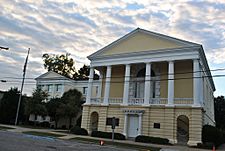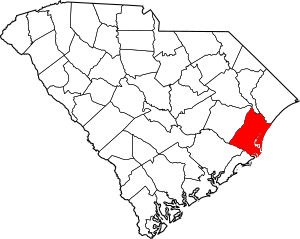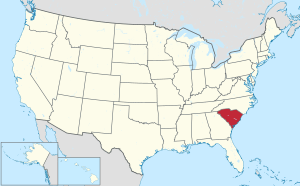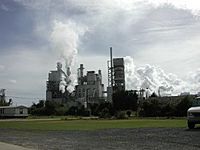Georgetown County, South Carolina facts for kids
Quick facts for kids
Georgetown County
|
||
|---|---|---|

Georgetown County Courthouse
|
||
|
||

Location within the U.S. state of South Carolina
|
||
 South Carolina's location within the U.S. |
||
| Country | ||
| State | ||
| Founded | 1769 | |
| Seat | Georgetown | |
| Largest city | Georgetown | |
| Area | ||
| • Total | 1,035 sq mi (2,680 km2) | |
| • Land | 814 sq mi (2,110 km2) | |
| • Water | 221 sq mi (570 km2) 21%% | |
| Population
(2020)
|
||
| • Total | 63,404 | |
| • Density | 61.260/sq mi (23.653/km2) | |
| Time zone | UTC−5 (Eastern) | |
| • Summer (DST) | UTC−4 (EDT) | |
| Congressional district | 7th | |
Georgetown County is a county located in the U.S. state of South Carolina. As of the 2020 census, the population was 63,404. Its county seat is Georgetown. The county was founded in 1769. It is named for George III of the United Kingdom.
Georgetown County comprises the Georgetown, SC Micropolitan Statistical Area, which is also included in the Myrtle Beach-Conway, SC-NC Combined Statistical Area.
Contents
Geography
According to the U.S. Census Bureau, the county has a total area of 1,035 square miles (2,680 km2), of which 814 square miles (2,110 km2) is land and 221 square miles (570 km2) (21%) is water.
Georgetown County has several rivers, including the Great Pee Dee River, the Waccamaw River, Black River, and Sampit River, all of which flow into Winyah Bay. The Santee River, which forms the southern boundary of the county, empties directly into the Atlantic. The Intracoastal Waterway crosses the county and Winyah Bay. The rivers and the bay have had a decisive effect on human development of the area, especially as the city of Georgetown has an excellent seaport and harbor.
Georgetown County is a diverse county with four distinct areas:
1. The Atlantic coastline, also called Waccamaw Neck, including the communities of Murrells Inlet, Litchfield, Pawleys Island and DeBordieu, is part of "The Grand Strand" (beach), which includes Myrtle Beach to the north. The Georgetown County part of the Grand Strand used to be rural, but is exploding with development today. Condos line the shoreline at Litchfield, and many of the old cottages at Pawleys are being demolished for larger houses. DeBordieu is a gated community.
Empty beachfront has disappeared and wild areas are rapidly vanishing. A few wilder areas are being saved, as these provide critical habitat as part of the Atlantic Flyway for migratory birds. Huntington Beach State Park preserves some of the coastline and coastal marshes in the northern section, with nearby Brookgreen Gardens preserving a historical rice plantation and some forest. Brookgreen Gardens, with a nature center and many outdoor sculptures, is a popular tourist spot.
The University of South Carolina and Clemson University maintain the Belle W. Baruch research site at Hobcaw Barony on Waccamaw Neck. The islands around the outlet of Winyah Bay are designated as the "Tom Yawkey Wildlife Center Heritage Preserve". This area is home to the northernmost naturally occurring hammocks of South Carolina's signature sabal palmetto tree.
2. The riverfronts have had little recent development. Such properties were once used for rice plantations, using a rice variety brought from Africa. After the Civil War, and the loss of slave labor, the plantations gradually ceased production. Today they are primarily wild areas, accessible only by boat. In some areas, the earthworks, such as dikes and water gates used for rice culture, still exist, as well as a few of the plantation houses. Litchfield Plantation has been redeveloped as a country inn; other properties have been developed as planned residential communities. Great blue herons, alligators, and an occasional bald eagle can be seen along the waterways. Fishing is a popular activity.
A tiny community accessible only by boat is on Sandy Island, in the Pee Dee River. Residents are descendants of slaves who worked plantations on the island, and they are trying to keep out development. Recently the Federal government began buying land along the rivers for the new Waccamaw Wildlife Refuge, which is intended to protect such wild areas. The headquarters of the refuge will be at Yauhannah in the northern part of the county.
3. Georgetown is a small historic city founded in colonial times. It is a popular tourist area and a port for shrimp boats. Yachting "snowbirds" are often seen at the docks in spring and fall; these people follow the seasons along the Intracoastal waterway.
4. The inland rural areas are thinly populated. Some upland areas are good for agriculture or forestry. Several Carolina bays are thought to be craters from a meteor shower. These areas are rich in biodiversity. Carvers Bay, the largest, was extensively damaged by use as a practice bombing range by US military forces during World War II. Draining of the bay has further damaged its environment.
Adjacent counties
- Williamsburg County - west
- Horry County - north
- Berkeley County - southwest
- Charleston County - southwest
National protected area
Demographics
| Historical population | |||
|---|---|---|---|
| Census | Pop. | %± | |
| 1790 | 22,122 | — | |
| 1800 | 22,938 | 3.7% | |
| 1810 | 15,679 | −31.6% | |
| 1820 | 17,603 | 12.3% | |
| 1830 | 19,943 | 13.3% | |
| 1840 | 18,274 | −8.4% | |
| 1850 | 20,647 | 13.0% | |
| 1860 | 21,305 | 3.2% | |
| 1870 | 16,161 | −24.1% | |
| 1880 | 19,613 | 21.4% | |
| 1890 | 20,857 | 6.3% | |
| 1900 | 22,846 | 9.5% | |
| 1910 | 22,270 | −2.5% | |
| 1920 | 21,716 | −2.5% | |
| 1930 | 21,738 | 0.1% | |
| 1940 | 26,352 | 21.2% | |
| 1950 | 31,762 | 20.5% | |
| 1960 | 34,798 | 9.6% | |
| 1970 | 33,500 | −3.7% | |
| 1980 | 42,461 | 26.7% | |
| 1990 | 46,302 | 9.0% | |
| 2000 | 55,797 | 20.5% | |
| 2010 | 60,158 | 7.8% | |
| 2020 | 63,404 | 5.4% | |
| U.S. Decennial Census 1790-1960 1900-1990 1990-2000 2010-2013 2020 |
|||
2010 census
As of the 2010 United States Census, there were 60,158 people, 24,524 households, and 17,282 families living in the county. The population density was 73.9 inhabitants per square mile (28.5/km2). There were 33,672 housing units at an average density of 41.4 per square mile (16.0/km2). The racial makeup of the county was 63.2% white, 33.6% black or African American, 0.5% Asian, 0.2% American Indian, 1.6% from other races, and 0.9% from two or more races. Those of Hispanic or Latino origin made up 3.1% of the population. In terms of ancestry, 13.5% were English, 9.0% were Irish, 8.7% were American, and 7.6% were German.
Of the 24,524 households, 29.1% had children under the age of 18 living with them, 50.8% were married couples living together, 15.6% had a female householder with no husband present, 29.5% were non-families, and 25.4% of all households were made up of individuals. The average household size was 2.43 and the average family size was 2.89. The median age was 45.4 years.
The median income for a household in the county was $42,666 and the median income for a family was $54,115. Males had a median income of $39,127 versus $28,390 for females. The per capita income for the county was $23,942. About 13.2% of families and 19.7% of the population were below the poverty line, including 32.3% of those under age 18 and 11.1% of those age 65 or over.
2020 census
| Race | Num. | Perc. |
|---|---|---|
| White (non-Hispanic) | 41,186 | 64.96% |
| Black or African American (non-Hispanic) | 18,051 | 28.47% |
| Native American | 111 | 0.18% |
| Asian | 258 | 0.41% |
| Pacific Islander | 27 | 0.04% |
| Other/Mixed | 1,546 | 2.44% |
| Hispanic or Latino | 2,225 | 3.51% |
As of the 2020 United States census, there were 63,404 people, 25,498 households, and 17,334 families residing in the county.
Communities
City
- Georgetown (county seat)
Towns
- Andrews (partly in Williamsburg County)
- Pawleys Island
Census-designated place
Unincorporated communities
- DeBordieu
- Kensington
- Litchfield Beach
- North Santee
- Oatland
- Plantersville
- Prince George
- Sampit
- Sandy Island
- Yauhannah
See also
 In Spanish: Condado de Georgetown para niños
In Spanish: Condado de Georgetown para niños





